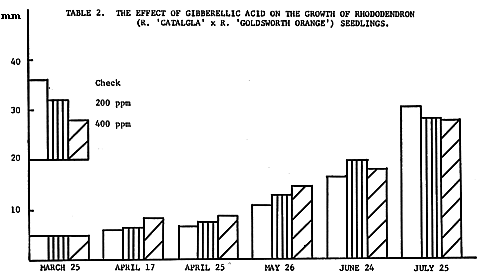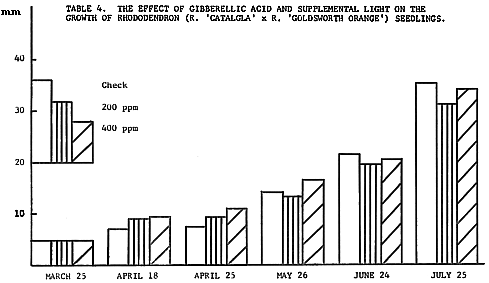QBARS - v12n2 Gibberellic Acid-It's Effect on the Growth of Rhododendron Seedlings
Gibberellic Acid - Its Effect on the Growth of Rhododendron Seedlings With and Without Supplemental Light
Robert L. Ticknor
Department of Landscape Architecture University of Massachusetts
Contribution 1150 of the University of Massachusetts, College of Agriculture Experiment, Amherst, Mass.
Gibberellic acid has received many glowing reports of increased plant growth, earlier flowering, and other effects. Many Rhododendron seedlings grow very slowly for the first six months till the seedlings have increased in size considerably. If gibberellic acid could increase the rate of growth at an early stage it would be very helpful.
PROCEDURE
Examples of lepidote and elepidote rhododendron seedlings were used in this experiment. Seed of R. keiskei was obtained from an isolated plant at the Arnold Arboretum. Seed of a cross R. 'Catalgla' x R. 'Goldsworth Orange' was supplied by Mr. Dietrich Hobbie of Germany.
Pure sphagnum moss was used as a media for starting the seeds which were sown November 29, 1956. When two true leaves were formed, the plants were transplanted into soil in small flats containing 15 plants each. Gibberellic was sprayed on the seedlings on March 25, 1957 when seedlings of both types were approximately 5 millimeters high.
Concentrations of gibberellic acid used were 100, 200, and 400 parts per million. Four flats of R. keiskei seedlings were sprayed with each concentration while two flats of R. 'Catalgla' x R. Goldsworth Orange' were used. Half the flats were grown under the prevailing day length while the other half received supplemental incandescent light from 12 midnight to 6:00 A.M.

|
|---|

|

|

|
RESULTS
The results of this experiment are presented in graphic form in Tables 1-4. Each number represents the average height of the 15 plants in one flat.
A marked difference in response to gibberellic acid was noted between the lepidote R. keiskei and the elepidote R. 'Caltagla' x R. 'Goldsworth Orange.' Growth of R. keiskei was markedly stimulated producing a taller plant quickly with increasing effects with increasing concentration of gibberellic acid. Primarily, the increased height resulted from longer internodes. Secondary effects were stems of smaller diameter and leaves of reduced size. Formative effects of gibberellic acid disappeared in two months with the plants resuming a normal type of growth. Untreated plants were as large as treated plants in four to five months with much sturdier growth. No practical advantage appeared to result from the use of gibberellic acid since the type of growth was not desirable.
R. 'Catalgla' x R. 'Goldsworth Orange' did not prove to be as responsive to the gibberellic acid as R. keiskei. Four months after spraying the plants the check plants which were not treated with gibberellic acid were actually slightly larger.
Supplemental light proved to be a very effective method of stimulating growth. In four months the R. keiskei seedlings under supplemental light were as large as similar seedlings were at five months under prevailing light. Growth producing under supplemental light appeared to be normal. The difference in growth produced by different concentration of gibberellic acid was not as marked under supplemental light. Doorrnbos 1 has found that rhododendron growth is fastest with 2-1 hours of light and that 10 hours is a minimum for rapid growth.
CONCLUSIONS
Gibberellic acid increased the rate of growth of R. keiskei but did not stimulate the growth of R. 'Catalgla x R. 'Goldsworth Orange.'
The type of growth produced tended to be undesirable-thin, weak stems and smaller leaves, although normal type growth was resumed within two months.
Stimulation was temporary since untreated plants were as large as treated plants in four or five months. Supplemental light appears to he the most satisfactory method to increasing the rate of growth of rhododendron seedlings.
ACKNOWLEDGEMENT
The author wished to thank Merck, Sharp and Dohme for the sample of gibberellic acid used in this study.
1 Doorrnbos, J., Shortening the breeding cycle of Rhododendron Euphytica, 4:141-146. 1955

